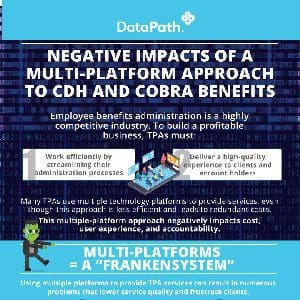Using a multi-platform approach to CDH and COBRA benefit administration can create numerous problems for third-party administrators. The following infographic highlights the negative impacts of a multi-platform approach and examines the advantages of a single solution.

Negative Impacts of a Multi-Platform Approach to CDH and COBRA Benefits
Employee benefits administration is a highly competitive industry. To build a profitable business, TPAs must:
- Work efficiently by streamlining their administrative processes
- Deliver a high-quality experience to clients and account holders
Many TPAs use multiple technology platforms to provide services, even though this approach is less efficient and leads to redundant costs. This multiple-platform approach negatively impacts cost, user experience, and accountability.
Multi-Platforms = A “Frankensystem”
Using multiple platforms to provide TPA services can result in numerous problems that lower service quality and frustrate clients.
Increased Costs
- Each platform requires its own development and support teams
- Additional staff required to manage separate platforms increases salary, benefits, and overhead costs
- Multiple independent platform vendors can’t offer the volume pricing available from a single vendor
Lack of Automation
- Different platforms often don’t effectively integrate
- May require duplicate data entry, which is inefficient and prone to human error
- Takes longer to make changes or update data
- Can take longer to make changes, update and verify data
Compliance Issues
- The employee benefits industry is highly regulated
- Compliance issues can arise when separate platforms don’t integrate
- Incorrect data and delayed communications can result in penalties to employers and loss of coverage to employees
Lack of Coordinated Support
- Different support teams for each platform reduces usage efficiency
- Quality of platform support can vary widely from vendor to vendor
- Even one vendor lacking a “big picture” view of the entire system can lead to bad decisions for the TPA and clients
Implementation and Functionality Problems
- Often takes longer to get multiple systems up and running
- Updates or new features on one platform may not work well with others
- Employees must be trained and maintain skills for multiple systems instead of just one
Using a single platform provides a better experience for everyone, including TPAs, employers, and participants.
Benefits of a Single-Platform Approach
Stable costs
Overall costs are more easily controlled and excesses reduced due to predictable overhead and labor costs with a single platform provider.
Lower fees
Lower fees made possible by reduced costs can create a competitive advantage.
Centralized portal
Delivering administration, banking, and investments through a single portal provides a more cohesive user experience for clients.
Global recordkeeping
TPAs who offer both CDH and COBRA administration can use one platform with single employer and participant records across all benefit types.
Superior customer service
Having a single point of contact allows for faster and more transparent problem-solving. If the TPA needs assistance, a single solutions provider has greater insight for addressing and resolving any issues.
Tighter data security
A single platform reduces the transfer of employer/employee data and minimizes the risk of breaches.
For 40 years, DataPath has been a pivotal force in the employee benefits, financial services, and insurance industries. The company’s flagship DataPath Summit platform offers an integrated solution for managing CDH, HSA, Well-Being, COBRA, and Billing. Through its partnership with Accelergent Growth Solutions, DataPath also offers expert BPO services, automation, outsourced customer service, and award-winning marketing services.


